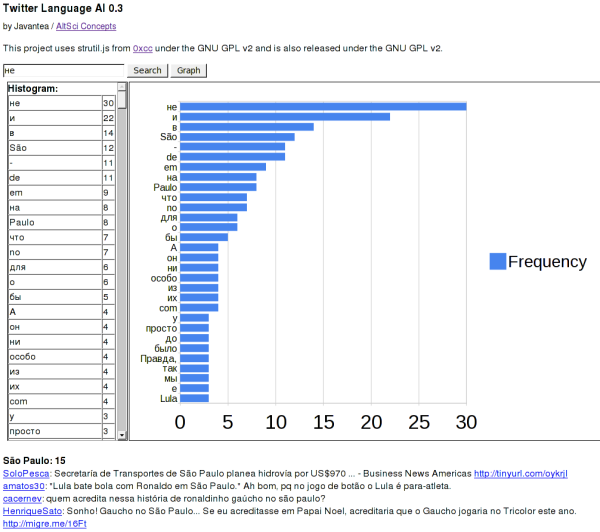Original Analysis: Sept 25, 2008
Updated Analysis: Aug 9 - Sept 8, 2009, Feb 15, 2010
Published: Feb 15, 2010
Japanese AI version 0.3
[sig]
Japanese AI version 0.1
[sig]
Over a year ago I released the concept and initial analysis of the Japanese AI project here. Since then I have been using the results off and on for translation, learning, and other projects. Not long after, I wrote a generic version of this project, AltSci Language AI using Twitter as the data source. It also utilized the Google Translate Language API to translate the conversations on the fly. It became obvious that the benefits of this type of language software would be quite useful, so I made a few quick user interface improvements to Japanese AI, so that I could release the full results.
Read more »
May 12, 2009
Hooray!
The Twitter Language AI is ready to be used! How do you use it? Type a word
into the input box, then click "Search". This will search Twitter for that
word. It will return the last 15 results and histogram all the words it finds.
This is very simple functionality, right? Why would someone want a histogram of
words spoken on a topic? For one, market research. If you know the word that
people associate with your brand or topic, you can market it using their words.
Yowch, that's almost like advertising, isn't it? Yup. The actual original
purpose for this was to learn foreign languages by translating the most common
words first (similar to my Japanese Language AI). The second interesting thing
to do with the Twitter Language AI is to click the "Graph" button. This will
take the data in the left and graph it on the right as shown in the image.
This is really interesting and useful for scientists who don't want to import
the data into a spreadsheet just to graph it. It uses the Google Visualization
API and sends no data to Google (just your IP address and HTTP headers) to draw
this, which is pretty cool.

Click the image above to use the Twitter Language AI.



